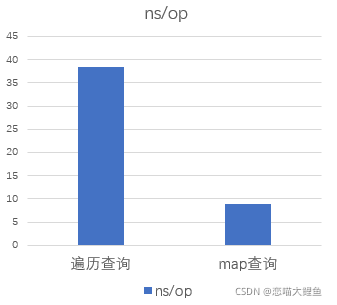这篇文章主要介绍“怎么用Go判断元素是否在切片中”的相关知识,小编通过实际案例向大家展示操作过程,操作方法简单快捷,实用性强,希望这篇“怎么用Go判断元素是否在切片中”文章能帮助大家解决问题。
如何判断元素是否在切片中,Golang 并没有提供直接的库函数来判断,最容易想到的实现便是通过遍历来判断。
以字符串切片为例,判断字符串切片中是否包含某个字符串。
// InSlice 判断字符串是否在 slice 中。
func InSlice(items []string, item string) bool {
for _, eachItem := range items {
if eachItem == item {
return true
}
}
return false
}这种实现时间复杂度是 O(n),n 为切片元素个数。
如果切片长度比较短(10以内)或者不是频繁调用,该性能是可以接受的。但是如果切片长度较长且频繁调用,那么这种方法的性能将无法接受,我们可以借助 map 优化一波。
先将 slice 转为 map,通过查询 map 来快速查看元素是否在 slice 中。
// ConvertStrSlice2Map 将字符串 slice 转为 map[string]struct{}。
func ConvertStrSlice2Map(sl []string) map[string]struct{} {
set := make(map[string]struct{}, len(sl))
for _, v := range sl {
set[v] = struct{}{}
}
return set
}
// InMap 判断字符串是否在 map 中。
func InMap(m map[string]struct{}, s string) bool {
_, ok := m[s]
return ok
}注意:使用空结构体 struct{} 作为 value 的类型,因为 struct{} 不占用任何内存空间。
fmt.Println(unsafe.Sizeof(bool(false))) // 1
fmt.Println(unsafe.Sizeof(struct{}{})) // 0虽然将 slice 转为 map 的时间复杂度为 O(n),但是只转换一次可以忽略。查询元素是否在 map 中的时间复杂度为 O(1)。
我们可以看下在元素数量为 26 的情况下,取中位元素,做个基准测试(benchmark),对比下二者的查询性能。
func BenchmarkInSlice(b *testing.B) {
for i := 0; i < b.N; i++ {
InSlice(sl, "m")
}
}
func BenchmarkInMap(b *testing.B) {
m := ConvertStrSlice2Map(sl)
for i := 0; i < b.N; i++ {
InMap(m, "m")
}
}执行测试命令输出:
D:\code\gotest\contain>go test -bench=.
goos: windows
goarch: amd64
pkg: main/contain
cpu: Intel(R) Core(TM) i7-9700 CPU @ 3.00GHz
BenchmarkInSlice-8 30564058 38.35 ns/op
BenchmarkInMap-8 134556465 8.846 ns/op
PASS
ok main/contain 3.479s
测试结果中,看到函数后面的 -8 个表示运行时对应的 GOMAXPROCS 的值。接着的一串很大的数字表示运行 for 循环的次数,也就是调用被测试代码的次数,最后的38.35 ns/op表示每次需要花费 38.35 纳秒。
以上是测试时间默认是 1 秒,也就是1秒的时间,如果想让测试运行的时间更长,可以通过 -lunchtime 指定,比如 5 秒。
性能对比:

可以预料到的是随着切片长度增长,性能差距会越来越大。
我们可以借助空接口 interface{} 来实现任意类型的切片转换为 map,方便调用方使用。
// ToMapSetStrictE converts a slice or array to map set with error strictly.
// The result of map key type is equal to the element type of input.
func ToMapSetStrictE(i interface{}) (interface{}, error) {
// check param
if i == nil {
return nil, fmt.Errorf("unable to converts %#v of type %T to map[interface{}]struct{}", i, i)
}
t := reflect.TypeOf(i)
kind := t.Kind()
if kind != reflect.Slice && kind != reflect.Array {
return nil, fmt.Errorf("the input %#v of type %T isn't a slice or array", i, i)
}
// execute the convert
v := reflect.ValueOf(i)
mT := reflect.MapOf(t.Elem(), reflect.TypeOf(struct{}{}))
mV := reflect.MakeMapWithSize(mT, v.Len())
for j := 0; j < v.Len(); j++ {
mV.SetMapIndex(v.Index(j), reflect.ValueOf(struct{}{}))
}
return mV.Interface(), nil
}
func main() {
var sl = []string{"a", "b", "c", "d", "e", "f", "g", "h", "i", "j", "k", "l", "m", "n", "o", "p", "q", "r", "s", "t", "u", "v", "w", "x", "y", "z"}
m, _ := ToMapSetStrictE(sl)
mSet = m.(map[string]struct{})
if _, ok := m["m"]; ok {
fmt.Println("in")
}
if _, ok := m["mm"]; !ok {
fmt.Println("not in")
}
}运行输出:
in
not in
上面的转换函数ToMapSetStrictE()已经放到开源 Go 工具库 go-huge-util,可直接通过 go mod 方式 import 使用。
import (
huge "github.com/dablelv/go-huge-util"
)
// 使用 go-huge-util
m, _ := huge.ToMapSetStrictE(sl)
mSet = m.(map[string]struct{})
// 或使用进一步封装的函数,不用再断言
mSet := huge.ToStrMapSetStrict(s)上面其实是利用 map 实现了一个 set(元素不重复集合),然后再判断某个 set 中是否存在某个元素。Golang 标准库并没有 set,但是我们可以用 map 来间接实现,就像上面那样子。
如果想使用 set 的完整功能,如初始化、Add、Del、Clear、Contains 等操作,推荐使用 Github 上成熟的开源库 golang-set,描述中说 Docker 用的也是它。库中提供了两种 set 实现,线程安全和非线程安全的 set。
golang-set 提供了五个生成 set 的函数:
// NewSet creates and returns a reference to an empty set. Operations
// on the resulting set are thread-safe.
func NewSet(s ...interface{}) Set {}
// NewSetWith creates and returns a new set with the given elements.
// Operations on the resulting set are thread-safe.
func NewSetWith(elts ...interface{}) Set {}
// NewSetFromSlice creates and returns a reference to a set from an
// existing slice. Operations on the resulting set are thread-safe.
func NewSetFromSlice(s []interface{}) Set {}
// NewThreadUnsafeSet creates and returns a reference to an empty set.
// Operations on the resulting set are not thread-safe.
func NewThreadUnsafeSet() Set {}
// NewThreadUnsafeSetFromSlice creates and returns a reference to a
// set from an existing slice. Operations on the resulting set are
// not thread-safe.
func NewThreadUnsafeSetFromSlice(s []interface{}) Set {}下面借助 golang-set 来判断切片中是否存在某个元素。
package main
import (
"fmt"
mapset "github.com/deckarep/golang-set"
)
func main() {
var sl = []interface{}{"a", "b", "c", "d", "e", "f", "g", "h", "i", "j", "k", "l", "m", "n", "o", "p", "q", "r", "s", "t", "u", "v", "w", "x", "y", "z"}
s := mapset.NewSetFromSlice(sl)
fmt.Println(s.Contains("m")) // true
fmt.Println(s.Contains("mm")) // false
}关于“怎么用Go判断元素是否在切片中”的内容就介绍到这里了,感谢大家的阅读。如果想了解更多行业相关的知识,可以关注亿速云行业资讯频道,小编每天都会为大家更新不同的知识点。
免责声明:本站发布的内容(图片、视频和文字)以原创、转载和分享为主,文章观点不代表本网站立场,如果涉及侵权请联系站长邮箱:is@yisu.com进行举报,并提供相关证据,一经查实,将立刻删除涉嫌侵权内容。